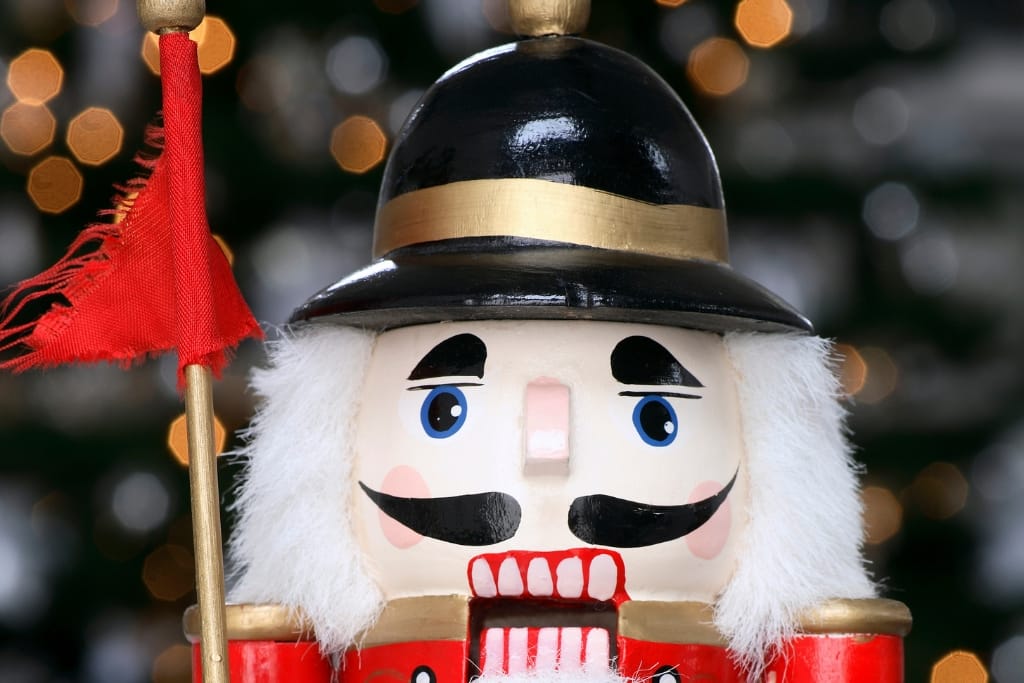Transforming a simple piece of wood into a vibrant and intricate nutcracker is an art form brimming with creativity, tradition, and joy.
Whether you're captivated by the charm of a brightly colored soldier or enchanted by the elegance of a regal king, painting nutcrackers allows you to add a personal touch to a beloved holiday classic.
This artistic journey not only enhances your skills but also contributes to festive home décor that friends and family will admire.
As you embark on this creative endeavor, let your imagination and brush take center stage.
Let's address some of the most frequently asked questions about this delightful craft to help you get started.
1)) What Types Of Paint Are Best For Nutcracker Painting?
Choosing the right type of paint is vital for achieving a vibrant and long-lasting finish on your nutcracker.
Acrylic paint is one of the most popular choices for nutcracker painting due to its excellent coverage and quick drying time.
It adheres well to wood surfaces and is available in a wide array of colors, making it easy to find hues that suit your design aesthetic.
If you prefer a more traditional look, consider using oil paints, which provide rich, vivid colors and a smooth finish.
However, keep in mind that oil paints take longer to dry. For those interested in a glossy, durable finish, enamel paint is another excellent option, ideal for detailed work and achieving a high-shine effect.
Regardless of your choice, always ensure your paints are non-toxic, especially if your nutcrackers will be handled by children.
By selecting the appropriate paint, you lay the foundation for creating a beautifully crafted piece that can be enjoyed for years to come.
2)) How Do You Prepare A Nutcracker Surface For Painting?
Preparing a nutcracker surface for painting is a crucial step in ensuring the longevity and aesthetic appeal of your finished piece.
Start by gently sanding the entire wooden surface with fine-grit sandpaper to remove any rough edges or existing paint, creating a smooth canvas for your artwork.
After sanding, wipe down the nutcracker with a damp cloth to remove all dust and debris, which can interfere with paint adhesion.
Once completely dry, apply a coat of primer to seal the wood and provide a uniform base for the paint.
This step not only enhances the vibrancy of the colors used but also helps the paint adhere more effectively.
If the nutcracker features intricate details or textured areas, make sure to use a small brush to apply the primer evenly.
Proper preparation aids in achieving a professional-looking result, setting the stage for your colorful design vision to come to life.
3)) Are There Any Specific Techniques To Achieve Intricate Details?
When it comes to achieving intricate details in nutcracker painting, mastering a few specific techniques can make all the difference.
One effective method is using fine-tipped brushes that allow for precision in tight spaces and detailed work.
It's also advisable to employ the technique of layering, where you gradually build up color and detail through multiple thin applications, ensuring a crisp and refined outcome.
Utilizing a pencil or light chalk to outline complex patterns beforehand can serve as a helpful guide.
This way, you can trace over the guidelines with accurate and steady brushwork, resulting in cleaner lines.
For very small details, consider using a toothpick or a pin to apply minuscule dots of paint.
Patience and a steady hand are key when working with intricate designs, so take regular breaks to maintain focus and avoid hand fatigue.
With these techniques, you're well-equipped to bring even the most elaborate elements of your nutcracker to life, adding depth and personality to your creation.
4)) How Long Does It Take For Paint To Dry On Nutcracker Wood?
The drying time for paint on nutcracker wood largely depends on the type of paint used.
Acrylic paint, a popular choice due to its fast drying properties, typically dries to the touch within 15 to 30 minutes, allowing for quicker progress in your project.
However, it's advisable to wait at least an hour before applying additional layers to ensure the paint has fully set.
Oil paints, although known for their rich color and smooth finish, require a longer drying period, often taking several days to dry completely.
For this reason, patience is essential when using oils. Enamel paint, known for its glossy and durable finish, generally dries within a few hours but can take up to a day for full curing.
Environmental factors, such as humidity and temperature, also play a critical role in drying times, so always consider these conditions when planning your painting schedule.
Understanding these timeframes helps you manage your painting process efficiently, ensuring each layer is perfect before proceeding to the next.
5)) Can I Use Spray Paint For Larger Areas Of A Nutcracker?
Using spray paint for covering larger areas of a nutcracker can be an efficient and effective method, provided certain precautions are taken.
Spray paint offers a quick application that results in an even and smooth finish, eliminating brush strokes commonly seen with hand-painting.
Before beginning, ensure the area is properly ventilated and protect any sections of the nutcracker you don't wish to paint using painter's tape.
A suitable spray paint formulated for wood surfaces should be selected to ensure durability.
Applying multiple thin coats rather than one heavy coat is recommended to prevent drips and achieve a consistent color.
Allow adequate drying time between applications to build up a vibrant and solid finish without compromising the integrity of the paint.
This approach enables you to achieve professional-looking coverage while maintaining the charm and artistry of your nutcracker.
Pro-Tip: When using spray paint to cover larger areas of a nutcracker, always prioritize safety by wearing protective gear.
Equip yourself with protective eyewear, gloves, and a face mask to shield against paint fumes and particles.
This ensures a safer painting process and keeps you healthy while working on your creative project.
6)) What Tools Are Essential For Painting Nutcrackers Efficiently?
When painting nutcrackers efficiently, having the right tools can significantly impact the quality and ease of the process.
A set of high-quality paintbrushes is essential, with various sizes and shapes to accommodate different levels of detail, from broad strokes to intricate lines.
An artist's palette is handy for mixing colors, allowing you to achieve custom shades tailored to your design.
Fine-tipped detail brushes or even natural sponges can aid in applying paint precisely on the nutcracker's more detailed or textured areas.
In addition to brushes, masking tape or painter’s tape is useful for isolating sections of the nutcracker you wish to keep unpainted or to achieve clean, sharp lines.
For spray paint application, a spray box or drop cloth is crucial in catching overspray and protecting the surrounding area.
A comfortable, well-lit workspace enhances precision and focus. With these tools at your disposal, painting your nutcracker becomes a more organized and effective endeavor, allowing your creativity to flourish.
7)) How Do I Seal The Paint To Ensure Durability?
Sealing the paint on a nutcracker is an important final step to ensure its durability and long-lasting beauty.
The type of sealant you choose will depend on the finish you desire—matte, satin, or glossy.
Polyurethane is a versatile option, offering a robust protective layer that can withstand minor scratches and environmental exposure, while acrylic sealers are ideal for a quick-drying protective coat.
Before applying the sealant, make sure the paint is thoroughly dried.
Apply the sealant in a well-ventilated area, using even strokes or a spray application for consistent coverage.
This protective layer will guard against wear and tear, preserving the colors and details you've meticulously painted on your nutcracker.
By sealing your work, you maintain the craftsmanship and charm of your decorative piece for years to come.
8)) Can Beginners Paint Nutcrackers, And What Tips Should They Follow?
Beginners can certainly embark on the joyful task of painting nutcrackers, as long as they embrace a few helpful tips to ease the process.
Firstly, selecting the right materials is crucial. Begin with acrylic paints, as they are forgiving and dry quickly.
Use a variety of brush sizes to accommodate both broad areas and intricate details, ensuring a flexible yet controlled application.
Before starting, sketch the design lightly with a pencil on the nutcracker to serve as a guide.
Don’t hesitate to experiment with color mixing on a palette to create unique shades.
Patience is key, so take time to let each layer of paint dry before moving to the next.
Protect surfaces with old newspapers or a drop cloth to keep your workspace tidy.
Finally, practice makes perfect—meaning that with each nutcracker, your skills will improve.
Embracing these strategies helps novices take joy and pride in their creations, transforming blank nutcrackers into cherished decorative art pieces.
9)) Is It Necessary To Prime A Nutcracker Before Painting?
Priming a nutcracker before painting is a recommended step, especially if you want to achieve a smooth and long-lasting finish.
A good primer not only helps paint adhere better to the surface but also provides a uniform base, enhancing the vibrancy and accuracy of the colors applied afterward.
If the nutcracker has been previously painted or displays noticeable imperfections, priming will help in concealing these issues for a cleaner result.
Selecting a primer specifically designed for wood surfaces is important, as it ensures compatibility and durability for the paint applied on top.
Applying primer is a straightforward process, generally requiring one or two thin coats, followed by sanding to smooth out any irregularities.
By priming your nutcracker, you lay a solid foundation that maximizes the quality of your painting efforts, ultimately producing a more polished and professional-looking piece.
10)) How Do I Preserve The Vibrancy Of The Colors Over Time?
To preserve the vibrancy of the colors on your painted nutcracker over time, it is crucial to employ several protective measures.
First, ensure that the paint is completely dry before applying a sealant.
A high-quality clear coat or varnish not only offers a protective layer against dust and fingerprints but also helps maintain the paint's vibrancy by shielding it from harmful UV rays that can cause fading.
In addition, consider placing your nutcracker in a location that avoids direct sunlight and areas with extreme temperature fluctuations or high humidity, as these conditions can degrade the paint's quality.
Regularly dusting your nutcracker with a soft, dry cloth will help maintain its appearance by preventing the buildup of grime that can dull colors.
By integrating these care practices into your maintenance routine, you ensure that the nutcracker's colors stay as lively and striking as the day you painted them.
Recommended Nutcracker Embellishments Resources:
- Mini Hot Glue Gun Sets
- Multi-Purpose Clear Glue
- Christmas Candy (Red & White)
- Christmas Candy (Red & White / Green & White)
- Gold Glittery Fringes (To Put On Shoulders)
- Ostrich Feathers (To Put On Hat)
- Velvet Ribbon For Gift Wrapping
- Personalized Nameplates
- Shawl Clips
Conclusion
Embarking on the creative journey of painting nutcrackers is both a rewarding and fulfilling endeavor.
By following essential preparation steps like priming and sealing, you ensure the longevity and durability of your painted pieces.
Armed with quality paints and a willingness to practice, beginners can transform simple nutcrackers into vibrant, cherished pieces of art.
Each careful choice—from selecting materials to protecting the final product—plays a crucial role in bringing your artistic vision to life.
Through patience, practice, and proper care, your nutcrackers will continue to bring joy and aesthetic delight for years to come, becoming timeless treasures that capture the spirit of creativity.
Download Our Free E-book!







